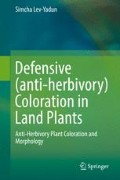Abstract
This central part of the book focuses on intimidation of herbivores by signaling/advertisement, in many ways the opposite strategy of camouflage and some other related visual defenses discussed in previous chapters. In spite of the contrasting strategies (crypsis versus conspicuousness or looking non-tempting/masquerade versus looking dangerous) there are cases where the same visual characters can serve as camouflage or related defense at long distances, and for aposematism at a closer range.
Access this chapter
Tax calculation will be finalised at checkout
Purchases are for personal use only
References
Barnett JB, Cuthill IC (2014) Distance-dependent defensive coloration. Curr Biol 24:R1157–R1158
Benson L (1982) The cacti of the United States and Canada. Stanford University Press, Stanford
Cott HB (1940) Adaptive coloration in animals. Methuen & Co. Ltd., London
Darwin C (1877) The different forms of flowers on plants of the same species. John Murray, London
Edmunds M (1974) Defence in animals. A survey of anti-predator defences. Longman Group Ltd., Harlow
Endler JA, Mappes J (2004) Predator mixes and the conspicuousness of aposematic signals. Am Nat 163:532–547
Faegri K, van der Pijl L (1979) The principles of pollination ecology, 3rd edn. Pergamon Press, Oxford
Gittleman JL, Harvey PH (1980) Why are distasteful prey not cryptic? Nature 286:149–150
Heath JJ, Cipollini DF, Stireman JO III (2013) The role of cartenoids and their derivatives in mediating interactions between insects and their environment. Arthropod Plant Interact 7:1–20
Keasar T, Kishinevsky M, Shmida A, Gerchman Y, Chinkov N, Koplovich A, Katzer G (2013) Plant-derived visual signals may protect beetle herbivores from bird predators. Behav Ecol Sociobiol 67:1613–1622
Lev-Yadun S (2001) Aposematic (warning) coloration associated with thorns in higher plants. J Theor Biol 210:385–388
Lev-Yadun S (2013c) Does chemical aposematic (warning) signaling occur between host plants and their potential parasitic plants? Plant Signal Behav 8:e24907
Lindström L, Alatalo RV, Mappes J (1999) Reactions of hand-reared and wild-caught predators toward waringly colored, gregarious, and conspicuous prey. Behav Ecol 10:317–322
Mappes J, Marples N, Endler JA (2005) The complex business of survival by aposematism. Trends Ecol Evol 20:598–603
Nishida R (2002) Sequestration of defensive substances from plants by Lepidoptera. Annu Rev Entomol 47:57–92
Poulton EB (1890) The colours of animals. Their meaning and use. Especially considered in the case of insects, 2nd edn. Kegan Paul, Trench, Trübner & Co Ltd, London
Ridley HN (1930) The dispersal of plants throughout the world. L. Reeve & Co Ltd, Ashford
Rothschild M (1972) Some observations on the relationship between plants, toxic insects and birds. In: Harborne JB (ed) Phytochemical ecology. Academic Press, London, pp 1–12
Rothschild M (1980) Remarks on carotenoids in the evolution of signals. In: Gilbert LE, Raven PH (eds) Coevolution of animals and plants. University of Texas Press, Austin, pp 20–51
Roze JA (1996) Coral snakes of the Americas: biology, identification, and venoms. Krieger Publishing Company, Malabar
Ruxton GD, Sherratt TN, Speed MP (2004) Avoiding attack. The evolutionary ecology of crypsis, warning signals & mimicry. Oxford University Press, Oxford
Savage JM, Slowinski JB (1992) The colouration of the venomous coral snakes (family Elapidae) and their mimics (families Aniliidae and Colubridae). Biol J Linn Soc 45:235–254
Schaefer HM, Ruxton GD (2011) Plant-animal communication. Oxford University Press, New York
Schaefer HM, Schaefer V, Vorobyev M (2007) Are fruit colors adapted to consumer vision and birds equally efficient in detecting colorful signals? Am Nat 169(Suppl):S159–S169
Smith SM (1975) Innate recognition of coral snake pattern by a possible avian predator. Science 187:759–760
Smith SM (1977) Coral-snake pattern recognition and stimulus generalization by naïve great kiskadees (Aves: Tyrannidae). Nature 265:535–536
Snow B, Snow D (1988) Birds and berries. A study of an ecological interaction. T. & A. D. Poyser, Calton
Stiles EW (1982) Fruit flags: two hypotheses. Am Nat 120:500–509
Tullberg BS, Merilaita S, Wiklund C (2005) Aposematism and crypsis combined as a result of distance dependence: functional versatility of the colour pattern in the swallowtail butterfly larva. Proc R Soc Lond B 272:1315–1321
van der Pijl L (1982) Principles of dispersal in higher plants, 3rd edn. Springer-Verlag, Berlin
Weiss MR (1995) Floral colour change: a widespread functional convergence. Am J Bot 82:167–195
Wickler W (1968) Mimicry in plants and animals. Weidenfeld and Nicolson, London
Willson MF (1983) Plant reproductive ecology. Wiley, New York
Willson MF, Whelan CJ (1990) The evolution of fruit color in fleshy-fruited plants. Am Nat 136:790–809
Author information
Authors and Affiliations
Rights and permissions
Copyright information
© 2016 Springer International Publishing Switzerland
About this chapter
Cite this chapter
Lev-Yadun, S. (2016). Aposematism. In: Defensive (anti-herbivory) Coloration in Land Plants. Springer, Cham. https://doi.org/10.1007/978-3-319-42096-7_23
Download citation
DOI: https://doi.org/10.1007/978-3-319-42096-7_23
Published:
Publisher Name: Springer, Cham
Print ISBN: 978-3-319-42094-3
Online ISBN: 978-3-319-42096-7
eBook Packages: Biomedical and Life SciencesBiomedical and Life Sciences (R0)

